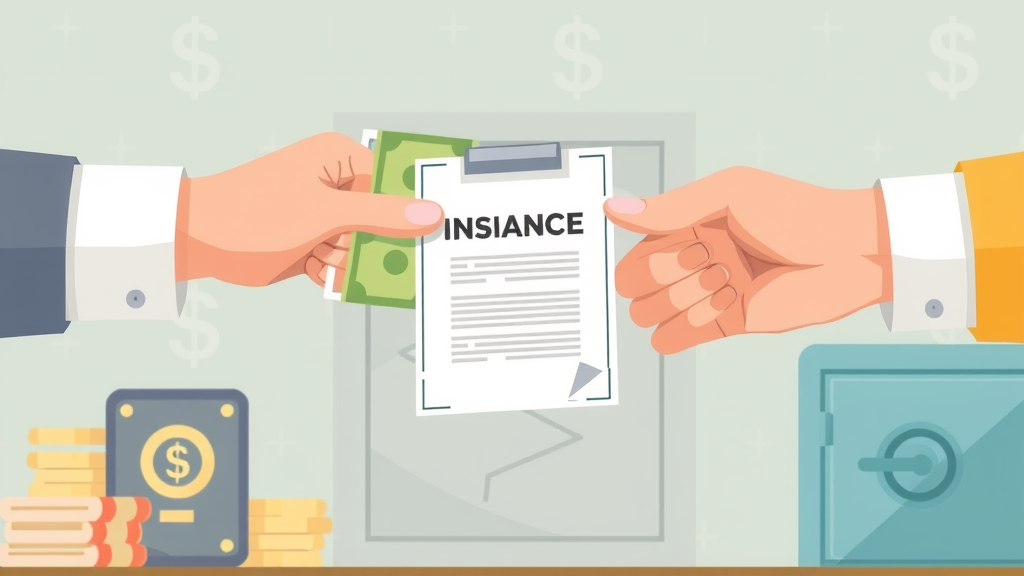Hook: Did you know that more Americans are now using permanent life insurance to build wealth—sometimes outpacing traditional stock portfolios during bear markets? Insurance as an investment is no longer an open secret reserved for the ultra-wealthy or experienced business owner. With the right strategy, you can harness the hidden power of insurance products to achieve long-term financial security—and even outsmart market volatility. Read on to discover smart growth secrets the pros don’t want you to miss.
Why Insurance as an Investment Demands Attention: Eye-Opening Facts
Insurance as an investment is often overlooked, yet it has transformed the way individuals and families think about building wealth beyond ordinary protection. As stock markets fluctuate and interest rates shift, insurance products like universal life insurance and indexed universal life insurance provide unique financial opportunities. These insurance policies offer not only a death benefit but also the potential to accumulate tax-advantaged cash value over time.
Recent industry data reveals that cash value life insurance policies, including permanent life insurance , have consistently grown in popularity, especially among those seeking both a strong retirement plan and legacy planning. For example, many business owners and savvy investors have begun leveraging the pros and cons of these tools as part of a diversified financial plan . With flexible policy designs, tailored riders, and the ability to adapt to market changes, insurance as an investment is now part of mainstream financial planning conversations.
- How insurance as an investment works
- Types of life insurance policies for investment
- Pros and cons of using insurance products for investment
- Differences between universal life, indexed universal life, and other insurance policies
- How insurance as an investment fits into a financial or retirement plan

The Foundation: Understanding Insurance as an Investment
Defining Insurance as an Investment: Beyond Traditional Protection
When you think of insurance, you likely imagine protection—guarding your family against hardship if the unexpected happens. However, insurance as an investment goes beyond basic protection. Certain life insurance policies , notably universal life , indexed universal life , and whole life insurance policy , include an investment component. These policies allow your premiums to fund both a death benefit and a separate cash value account, which grows over time, often with tax advantages.
This cash value can serve as a supplemental retirement fund, a source of emergency savings, or a tool for passing wealth to the next generation. Unlike traditional term life insurance , which provides coverage for a set period and no cash value, permanent life insurance keeps you covered for life and supports risk-averse, steady growth alongside insurance protection.
How Life Insurance Policy Types Offer Investment Potential
Not all insurance policies are designed for investment. Permanent life insurance policies —including whole life insurance and universal life insurance —provide a cash value feature. Part of each premium payment funds this account, which can grow at a fixed or variable interest rate based on the product type. With indexed universal life policies , the cash value is tied to major market indices (like the S&P 500), offering the upsides of market participation and floors to minimize downside risk.
These features make certain insurance products uniquely attractive. For those seeking capital appreciation without the wild swings of stocks, permanent life insurance offers stability, predictable growth, and the flexibility to borrow against policy value or make tax-free withdrawals under certain circumstances. By contrast, term life serves only a risk management function without an investment angle.

Insurance Products vs. Conventional Investments: What Sets Them Apart?
Insurance products differ from conventional investments like stocks or mutual funds in several important ways. First, insurance provides both protection (the death benefit) and a cash value accumulation, while stocks are solely investment vehicles. Unlike a retirement account or brokerage portfolio, life insurance cash value typically grows tax-deferred and isn’t directly exposed to market volatility unless you choose certain indexed products.
This unique combination aligns with risk-averse investors and those who prioritize wealth transfer or estate planning advantages. For example, permanent life insurance policies may be designed so that cash value grows steadily over time, regardless of stock market downturns. Many families and high-net-worth individuals leverage insurance as the bedrock of a diversified financial plan , rather than relying exclusively on market-linked investments.
"Many permanent life insurance policies provide both protection and the potential for cash value growth—making them unique financial tools."
Types of Life Insurance That Serve As Investment Vehicles
Universal Life Insurance: Flexible Coverage and Growth
Universal life insurance is one of the most versatile life insurance policies available, offering flexible premiums and adjustable death benefits. What makes universal life compelling for investment is its ability to accumulate cash value at a minimum guaranteed interest rate—while still offering the option to increase payments for accelerated growth. The cash value component grows tax-deferred, and policyholders can access these funds, often through tax-advantaged loans or withdrawals.
Many business owners favor universal life insurance because its flexibility allows for policy customization as financial needs evolve. Whether used to fund a buy-sell agreement or supplement retirement income, universal life can adapt to fit nearly any stage of a comprehensive financial plan . Its adaptability sets it apart from more rigid whole life insurance or simpler term life coverage.
Indexed Universal Life: Linking Returns to Market Indices
Indexed universal life insurance is quickly gaining traction among individuals who seek a balance between growth potential and downside protection. A hybrid between universal life and market-based investments, indexed universal life policies credit interest to the cash value based on the performance of a selected stock index, like the S&P 500. Importantly, these policies often include a floor (such as 0%) to shield the cash value from loss even when markets perform poorly.
This structure offers the potential for higher returns compared to other permanent life insurance policies , while still maintaining the core protection aspect of life insurance. For those concerned about inflation, market volatility, or simply wanting to diversify beyond bonds and stocks, indexed universal life insurance is an attractive middle ground—serving as a cornerstone of advanced financial planning for retirement plans and legacy strategies.
Whole Life Insurance Policy: Steady Cash Value Accumulation
A whole life insurance policy is the classic form of permanent life insurance, prized for its guaranteed death benefit and consistency. Premiums are fixed, and a portion is invested by the insurance company in a general account, producing stable—but often more conservative—cash value growth through dividends or guaranteed interest payments. Whole life is renowned as a safe choice for those seeking protection and steady, predictable wealth accumulation.
Because of its reliability, many families and conservative investors incorporate whole life policies into intergenerational legacy plans, college funding strategies, or simply as a source of long-term, tax-advantaged savings. It exemplifies the wealth-building side of insurance as an investment , especially for those less interested in chasing high returns and more focused on capital preservation and certainty.

Permanent Life Insurance vs. Term Life: Which Builds Wealth?
When comparing permanent life insurance to term life insurance , the difference is dramatic from an investment perspective. Term life provides affordable coverage for a set number of years and pays the death benefit if the insured passes during that period, but builds no cash value. It is ideal for pure protection—satisfying the needs of families during high-responsibility years or for those on a tight budget.
In contrast, permanent life insurance policies such as whole life, universal life, and indexed universal life, bundle lifelong protection with a savings or investment component. Over decades, the steady cash value growth, along with the ability to borrow or withdraw, makes permanent policies a favorite for those who want insurance AND wealth-building capabilities. For investors looking to supplement a retirement plan or transfer assets efficiently, permanent life is a superior avenue compared to term coverage.
| Policy Type | Cash Value Growth | Premium Flexibility | Investment Risk | Death Benefit | Best For |
|---|---|---|---|---|---|
| Universal Life | Variable (minimum guaranteed interest rate) | Flexible | Moderate to Low | Adjustable | Those seeking flexibility and growth options |
| Indexed Universal Life | Tied to market indices with floors | Flexible | Potential for higher returns, capped risk | Adjustable | Market-savvy policyholders |
| Whole Life | Guaranteed, steady (fixed or with dividends) | Fixed | Low | Guaranteed for life | Risk-averse, long-term planners |
| Term Life | None | Usually fixed | None | High (during term only) | Affordability, temporary needs |
How Insurance as an Investment Works Day-to-Day
Building Cash Value Over Time Within Life Insurance Policies
With investment-oriented life insurance policies , the real magic happens inside the cash value account. Every premium payment is split—some funds cover the cost of insurance, while the remainder accumulates as cash value. Over the years, that cash value earns interest or dividends, compounding in a tax-advantaged environment. The growth rate depends on the policy type: whole life delivers steady progress, universal life allows for higher potential based on interest and payment choices, and indexed universal life tracks market performance with protections against steep losses.
Savvy policyholders frequently monitor their cash value accumulation to ensure it aligns with their overarching financial plan . Additionally, the cash value can be accessed—either through policy loans or withdrawals—offering liquidity without closing the policy. This dual function as both a safety net and a nest egg makes insurance as an investment unique for wealth builders at any stage of life.

Policy Loans and Withdrawals: Accessing Your Investment
One key feature of insurance as an investment is the ability to borrow against your cash value, often at favorable rates and with minimal tax consequences. Unlike traditional loans, policy loans don’t require credit checks, and you can repay anytime. Most importantly, these funds aren’t taxable as income if structured properly, maintaining the tax-advantaged status of your insurance policy.
Withdrawals are also possible, typically on a tax-free basis up to your basis (amount paid in). However, excessive loans or withdrawals can reduce the death benefit and may even cause the policy to lapse if not managed well. Careful policy management—possibly with a financial advisor’s guidance—can help maximize both growth and flexibility while avoiding unwanted consequences.
Tax Benefits of Insurance Products as Investment Tools
The income tax benefits of insurance products are significant. Cash value accumulates tax-deferred, meaning you won’t pay taxes on growth until you access it (and in many cases, not even then). Policy loans are typically tax-free, and death benefits are usually paid out to beneficiaries income tax-free. This has made permanent life insurance especially attractive for legacy, estate planning, and supplementing retirement funds.
For high earners who have already maxed out their retirement accounts, or for business owners looking for ways to pass wealth more efficiently, insurance products are among the best solutions available. Tax efficiency is central to why insurance as an investment can be such a powerful part of a modern financial plan .

Using Insurance as a Retirement Plan Component
A growing number of Americans now treat life insurance as a distinct retirement plan ingredient. While not a substitute for IRAs or 401(k)s, insurance policies with cash value allow for supplemental income in retirement—without immediate tax consequences if structured as loans. This means retirees can tap cash value when stock markets are down, preserving other investments for recovery.
Indexed universal life and whole life insurance policies are increasingly used to hedge against longevity risk, market downturns, and sequence-of-returns risk. For people seeking stable income, principal protection, and tax-free generational wealth transfer, insurance as an investment delivers unique value when integrated into an overall financial plan .
Pros and Cons of Insurance as an Investment
"Insurance as an investment can align perfectly with risk-averse, long-term financial plans, but it's not for everyone."
- Tax-deferred growth
- Protection with investment potential
- Estate planning advantages
- Potential market participation via indexed universal life insurance
- Complexity of insurance products
- Fees and costs
- Limited liquidity
- Investment performance depends on product choice

Understanding the pros and cons is essential before committing to insurance as an investment. The primary pros are tax-advantaged growth, lifelong protection, and estate planning perks. These policies ensure your loved ones receive a death benefit while you enjoy potential growth or income during your lifetime. The ability to participate in market upswings (with indexed universal life insurance) is a modern twist that’s capturing investor interest.
But there are downsides: insurance products are not simple, and the underlying fees can erode returns if not managed well. Liquidity is more limited compared to savings or brokerage accounts, and investment gains are often capped or less aggressive than direct stock investments. Evaluating the best fit for your financial plan —possibly with advice from a skilled financial advisor—is crucial for success.
Who Should Consider Insurance as an Investment?
Business Owners: Leveraging Permanent Life Insurance for Financial Planning
Business owners often have unique financial needs—succession planning, buy-sell agreements, and protection from key person risk. Permanenet life insurance offers significant advantages, such as the ability to build tax-deferred cash value, fund buyouts, and ensure the business continues seamlessly if a key stakeholder passes away.
A universal life insurance policy or indexed universal life contract can also double as an executive benefit or retirement plan, supplementing other strategies. By choosing the right policy and structuring payments for maximum growth, business owners can leverage permanent life insurance as both a contingency plan and an investment vehicle.

Individuals Seeking Tax-Advantaged Wealth Building
High-income individuals and families often search for additional ways to grow their wealth tax-efficiently after maxing out traditional retirement accounts. Here, insurance as an investment shines. With flexible premium payments, tax-deferred growth, and policy loans that can provide tax-free income, the right insurance product becomes an asset class on its own.
Whether utilized for supplemental retirement income or as a safe harbor for excess wealth, indexed universal life and whole life policies serve as valuable wealth-building tools. Individuals can design policies to match unique goals, whether that's early retirement, legacy creation, or simply peace of mind during market volatility.
Families Focused on Legacy and Estate Transfer
For multigenerational families, life insurance policies remain a favored method for leaving a lasting legacy. The death benefit provides instant liquidity to heirs, often income tax-free and outside of probate, simplifying complex estate settlements. Permanent life insurance can also be structured for charitable bequests, trusts, or business succession—delivering maximum value to loved ones and good causes alike.
When combined with legal and tax guidance, insurance as an investment can dramatically improve estate efficiency and minimize friction or tax burdens for beneficiaries, making it an indispensable part of advanced legacy planning.
| Profile | Needs | Best Insurance Solution | Outcome |
|---|---|---|---|
| Business Owner, 45 | Funding buyout, tax-advantaged growth | Indexed Universal Life | Tax-deferred accumulation, legacy for family and partners |
| High Net Worth Individual, 38 | Wealth transfer, minimize estate taxes | Whole Life Insurance Policy | Guaranteed payout, cash value as emergency fund |
| Young Family, 33 | Affordable protection, college savings | Universal Life Insurance | Flexible coverage, builds cash for tuition |
Insurance Policy Design: Maximizing Investment Value
Choosing the Right Insurance Product and Features
Not all insurance policies are created equally for investment. Selecting the right insurance product means evaluating your risk tolerance, growth goals, and desired policy features. Universal life, indexed universal life, and whole life each offer unique trade-offs. Factors like minimum premium requirements, interest rate guarantees, and index participation rates should be carefully compared.
A skilled financial advisor can help you assess the ideal balance between protection, growth, and cost, designing a policy that evolves with you. Riders, payment schedules, and optional features contribute to the overall performance of your policy, so tailor your insurance as you would any major investment.

Key Riders and Policy Provisions That Impact Investment Growth
Policy riders are optional benefits that can enhance the value of your insurance investment. Common riders include accelerated death benefits, waiver of premium, long-term care, and additional purchase options. For investment-focused policies, "overfunding" riders or enhanced cash value riders enable faster cash accumulation without triggering income tax penalties.
It's essential to understand how charges, fees, and withdrawal rules impact growth. Some policies penalize excessive or early withdrawals. Always review the policy illustration and ask about cost of insurance, surrender charges, and underlying index caps if considering indexed universal life insurance.
Aligning Insurance with a Broader Financial Plan
A robust financial plan should harmonize insurance products with other investment vehicles, accounting for tax status, liquidity needs, and risk management. For example, blending permanent life insurance with stocks and bonds can provide both stability and upside potential, while reducing overall portfolio volatility.
Regularly review your policy performance alongside your full investment strategy, adjusting contributions or benefits as your goals evolve. When coordinated properly, insurance as an investment strengthens both wealth accumulation and protection—bringing you closer to your long-term dreams.
FAQs About Insurance as an Investment
Can Life Insurance Replace Traditional Investments?
While life insurance with investment features can complement your portfolio, it generally should not replace traditional investments like stocks, bonds, or mutual funds. Instead, insurance plays a unique role in providing protection, tax-deferral, and legacy benefits—serving as a stable foundation alongside conventional assets in your financial plan .
How Do Market Changes Impact Indexed Universal Life Insurance?
Indexed universal life insurance links cash value growth to the performance of chosen market indices. When markets rise, your policy’s credited interest rate can increase up to a cap; if markets fall, the policy usually has a floor (often 0%), preventing loss of cash value from negative market returns. This makes IUL a popular "middle ground" for risk-conscious investors.
Are There Risks to Using Life Insurance for Retirement Planning?
Yes, there are some risks. Policy fees, cost of insurance, or poor performance (if market-based credits are low) can limit cash value growth. Additionally, mismanaging loans or withdrawals may reduce your death benefit or trigger taxes. It’s crucial to coordinate with a financial advisor and continually review your policy within your retirement plan .
People Also Ask: Should you use insurance as an investment?
Experts agree that using insurance as an investment can be effective for long-term growth, protection, and tax advantages. However, it is most suitable for individuals who have maxed out other tax-advantaged accounts or have unique estate or legacy concerns.
People Also Ask: How much is $100,000 in life insurance per month?
The cost of a $100,000 life insurance policy per month varies significantly based on age, health, and the type of life insurance chosen. For a healthy individual, term life can be as low as $10–$30 per month, while permanent life insurance types may cost much more due to the investment and saving components.
People Also Ask: Is insurance considered investment?
While term life insurance is largely protection only, some insurance products —universal life, indexed universal life insurance, and whole life—do include an investment component, as they build cash value alongside the death benefit.
People Also Ask: Is insurance a good stock investment?
Insurance products—especially those with cash value—cannot be directly compared to stocks. While they provide stable, long-term growth and valuable protection, their returns are typically lower than direct stock investments. Instead, they serve as safe, steady assets within a diversified portfolio, rather than a replacement for equity market exposure.
Final Thoughts: Smart Moves with Insurance as an Investment
- Insurance as an investment is a long-term, stable approach for select financial goals.
- Product choice and proper policy design are vital.
- Always compare costs, fees, and benefits to other investments.
Exploring the concept of insurance as an investment can provide valuable insights into how certain insurance products can serve dual purposes—offering both protection and potential financial growth. For a comprehensive understanding, consider reading the article “ Is Whole Life Insurance a Good Investment in 2025? ” by NerdWallet, which delves into the benefits and drawbacks of whole life insurance as an investment vehicle. Additionally, the piece “ What’s wrong with using insurance as an investment? ” from CNN Money offers a critical perspective on the potential pitfalls and costs associated with using insurance products for investment purposes. These resources will equip you with a balanced view, helping you make informed decisions about incorporating insurance into your financial strategy.
 Add Row
Add Row  Add
Add 




Write A Comment